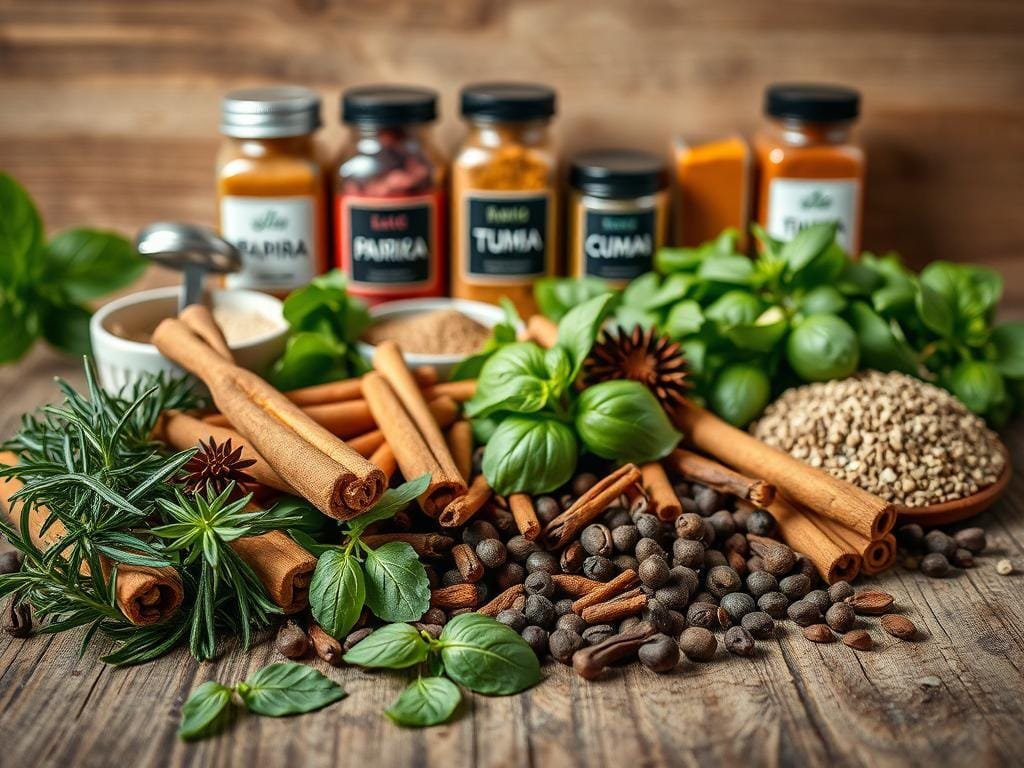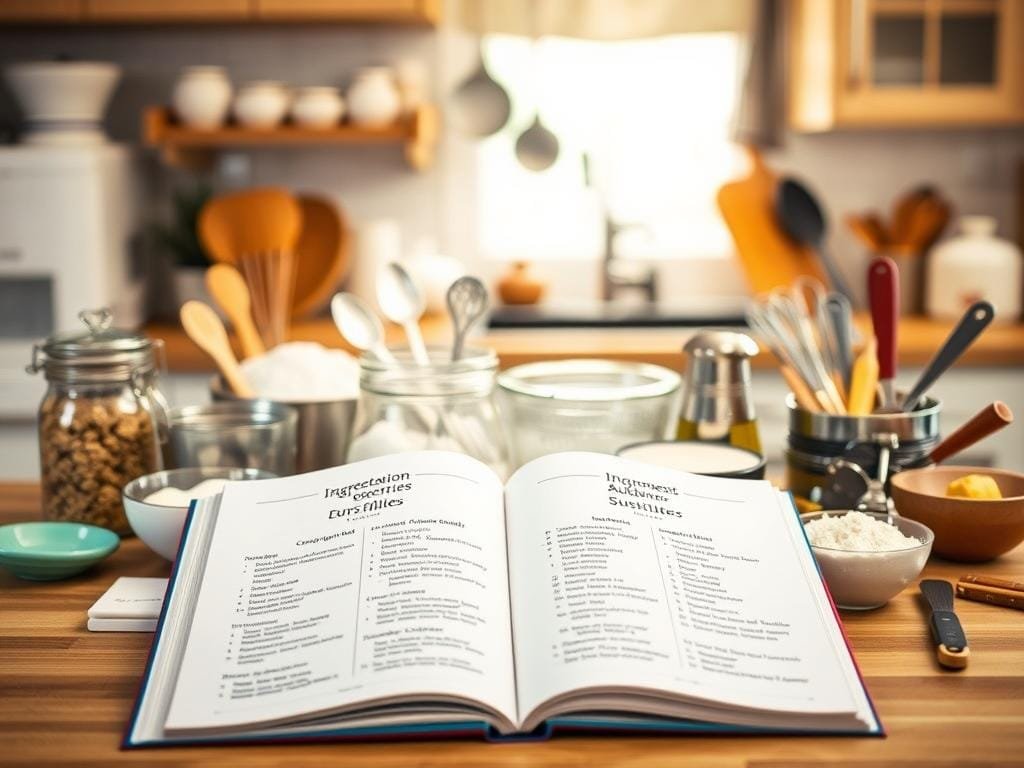Have you ever been cooking dinner and realized you’re missing a crucial ingredient? This happened to me last week. I was preparing my family’s beloved tomato basil soup and noticed I had no basil. Instead of worrying, I used dried oregano. The soup was a hit, offering a tasty new take on the dish. This experience led me to share some Herb and Spice Swaps that can rescue your meal from being dull.
Knowing Seasoning Alternatives can be a real lifesaver when you’re stuck. A little creativity lets you keep or even enhance the dish’s flavor. Let’s look at some easy Cooking Tips and Recipe Modifications for those times you’re missing an essential ingredient.
Key Takeaways
- Understand basic ratios for swapping fresh herbs with dried herbs.
- Explore alternatives to common ingredients like lemon juice, buttermilk, and eggs.
- Learn to substitute vegetable oil with healthier options like applesauce in baking.
- Discover practical replacements for common herbs and spices to maintain recipe flavors.
- Gain tips on incorporating fresh and dried herbs effectively in different recipes.
- Utilize plant-based alternatives like tofu and beans for a healthier twist in meat-centric dishes.
Understanding the Basics of Herb and Spice Swaps
Ever been cooking and realized you’re missing a key ingredient? We’ve all been there. That’s why knowing how to swap herbs and spices is so useful. It can save a recipe when you’re out of an ingredient or help cut down on kitchen costs. Plus, it lets you tailor recipes to your own tastes or needs.
So, why swap herbs and spices? Mainly, it’s to use what you already have. Let’s look at some times you might need to swap:
- Pantry Shortages: If you don’t have every herb or spice, try using something similar to keep your dish delicious.
- Dietary Adjustments: For instance, making a dish vegetarian by not using meat-based seasonings.
- International Flavors: You can create dishes with international tastes using spices you have at home.
Now, let’s see some specific examples to get a better idea:
| Original Ingredient | Swap | Ratio |
|---|---|---|
| Fresh herbs | Dried herbs | 1 Tbsp. fresh = 1 tsp. dried |
| Garlic clove | Garlic powder | 1 clove = 1/8 tsp. powder |
| Whole egg | Egg substitute | 1 egg = 1/4 cup substitute |
| Cajun seasoning | Blend of white pepper, garlic powder, onion powder, cayenne, paprika, black pepper | 1 tsp. Cajun = 1/2 tsp. each spice |
Getting good at these swaps not only makes you more flexible in the kitchen. It also lets you create dishes that taste how you like. Why swap? Because it makes cooking creative and fun!
The Power of Fresh vs. Dried Herbs
Cooking with fresh herbs makes dishes taste bright and vibrant. Dried herbs can’t match this flavor boost. Fresh herbs are key in certain recipes like pesto. They add a fresh and zesty taste due to their high water content.
Dried herbs are great for long-cooked meals like stews. They offer a concentrated flavor, much stronger than fresh. Knowing how to switch When to Use Fresh Herbs is key. The right tip makes a big difference.
Here are some tips for converting fresh to dried herbs:
- Use one teaspoon of dried herbs for each tablespoon of fresh (a 3:1 ratio).
- A 1/4 cup of dried onion flakes can replace one cup of fresh chopped onion.
- One tablespoon of dried onion powder equals one cup of fresh chopped onion.
- 1/4 teaspoon of ground ginger is the same as one teaspoon of fresh grated ginger.
| Fresh Herb | Dried Herb | Substitution Ratio |
|---|---|---|
| 1 tbsp Fresh Basil | 1 tsp Dried Basil | 3:1 |
| 1 tbsp Fresh Parsley | 1 tsp Dried Parsley | 3:1 |
| 1 tbsp Fresh Rosemary | 1 tsp Dried Rosemary | 3:1 |
Fresh herbs can stay good for about a week in the fridge. But basil may brown faster. Parsley and rosemary can last two weeks if stored right. Dried herbs, on the other hand, can last for years in the right conditions. Yet, their strength fades after three months.
Choosing When to Use Fresh Herbs over dried? Think about the recipe, the herb’s shelf life, and flavor power. This ensures your cooking always hits the mark!
Flavorful Alternatives to Common Herbs
Sometimes, you find you’re out of an essential herb while cooking. Herb swaps can save your meal. If you’re missing basil, try Oregano and Mint instead. Oregano works well in Mediterranean dishes with its strong flavor. Mint offers a refreshing taste for Southeast Asian dishes.
Run out of parsley? No problem. Try Cilantro and Celery Leaves as substitutes. Cilantro adds a bold, fresh taste to Latin American cuisine. Celery leaves bring a mild, aromatic touch, enhancing European soups and stews beautifully.
Missing thyme? Don’t worry. Thymus vulgaris has great replacements. Try Marjoram and Rosemary. Marjoram adds a sweet, floral flavor. Rosemary, with its pine-like scent, is perfect for hearty dishes and long cooks.
Here’s a quick guide to remember these swaps easily:
- Basil Substitutes: Oregano and Mint
- Parsley Alternatives: Cilantro and Celery Leaves
- Thyme Alternatives: Marjoram and Rosemary
Next time your pantry is missing an herb, remember these smart swaps. They don’t just fill in; they add new tastes to your dishes. Have fun experimenting. You might find a new favorite flavor for your cooking!
Creative Swaps for Common Spices
Have you ever started cooking only to realize you’re out of a key spice? No worries, I’ve got some great fixes for you! Cinnamon Alternatives: Nutmeg and Allspice are perfect substitutes. These spices add a warm, rich taste, making them great for swapping in sweet and savory recipes. Whether it’s for a pie or a stew, they’ll make your dish incredibly tasty.
Ran out of chili powder? Don’t stress! By combining paprika and cayenne, you get the same bright color and spicy flavor. This blend is fantastic in dishes like tacos and chili, giving them just the right heat and flavor.
Here’s a handy table of substitutions to help out:
| Ingredient | Substitute | Details |
|---|---|---|
| Cinnamon | Nutmeg or Allspice | Use in equal measure |
| Chili Powder | Paprika and Cayenne | Blend to taste for color and heat |
| Salted Butter | Margarine, Shortening, Vegetable Oil | Adjust salt content accordingly |
| White Sugar | Brown Sugar, Honey, Corn Syrup | Consider moisture and flavor differences |
| Milk | Dry Milk Powder, Evaporated Milk, Almond Milk | Adjust water ratio as needed |
These cooking tips can turn a cooking crisis into a delicious dish! Remember, being creative in the kitchen can lead you to new, exciting flavors and skills. Enjoy cooking and see your kitchen as an adventure zone! Happy cooking!
Aromatic Swaps in Soups and Stews
Hey there! Today, I want to chat about a delightful way to boost the flavor profiles of your soups and stews without reaching for the classic bay leaves. Most of us stock up on bay leaves all year round, but I’ve found that Bay Leaf Alternatives: Thyme and Oregano can really transform your dishes! These two herbs are perfect for anyone seeking aromatic cooking without losing that comforting depth and complexity.
Imagine you’re making a hearty beef stew. Instead of grabbing a bay leaf, why not try thyme and oregano? Both herbs are fantastic substitutes that not only enrich your broth or stock but also provide a lovely aromatic foundation to your meal. This is particularly critical now, as about 70% of consumers are looking to reduce salt intake – and these herbs offer flavorful, healthy alternatives.
In soups and stews, fresh herbs have been proven to retain up to 80% more flavor compared to dried counterparts. So, when you’re out of bay leaves, consider using fresh herbs to maintain that rich depth. If you can’t access fresh ones, dried thyme and oregano work just as well! Remember to replace dried herbs at least once a year or whenever their flavor begins to wane to keep your dishes exciting.
Here’s another perk – thyme and oregano are versatile. They’re crucial in about 60% of Greek and Mediterranean dishes, often starring in marinades and sauces. These herbs can also seamlessly blend into diverse culinary styles, making them indispensable in your pantry. Whether you’re preparing a classic chicken soup or an exotic vegetable stew, these swaps ensure your recipe doesn’t fall flat without bay leaves.
Let’s take it one step further. Enhancing your broths and stocks can be an aromatic adventure. A touch of rosemary or sage brings a whole new world of flavors to your pot, creating layers without overshadowing the main ingredients. This versatility is perfect for folks like you who enjoy experimenting in the kitchen.
So, next time you’re whipping up a soup or stew, remember: Bay Leaf Alternatives: Thyme and Oregano could be your culinary heroes. They’ll keep your dishes vibrant and your family happy! Give it a try and let your senses savor the aromatic wonders these herbs bring.
Happy cooking!
Using Extracts and Infusions as Swaps
Run out of vanilla extract? Don’t worry! Try Vanilla Extract Alternatives: Almond and Maple to save your dish. Almond extract adds a nutty sweetness, much like vanilla. But it’s strong, so use less. Typically, half the almond extract is enough.

Maple syrup makes a great swap too. It gives a rich, mellow sweetness, perfect for many dishes. Choose pure maple syrup for the best taste.
Citrus zest is another excellent choice. Use lemon or lime zest for a fresh twist. A bit of zest adds a refreshing tang, but don’t go overboard.
How about essential oils for a creative touch? One drop can replace:
- 1 teaspoon of dry herb
- 1 tablespoon of fresh herb
- 1 teaspoon of dry spice
- 1 teaspoon of citrus zest
- 1 teaspoon of flavoring/extract
Start with one drop to keep the flavor right. Always use food-grade essential oils for safety.
In conclusion, finding alternatives like Vanilla Extract Alternatives: Almond and Maple or using citrus zest offers great flavors. These swaps can save your recipes and add new tastes to your cooking. Happy cooking!
Herbal Blends: Crafting Your Own Seasoning Mixes
Making your own seasoning mixes is fun and useful for better cooking. It lets you craft flavorful all-purpose blends that fit what you like and need. I enjoy a mix with dried basil, oregano, rosemary, and thyme. This mix is great for many dishes, from soups to salads.
Store-bought herb mixes, like those from McCormick or Frontier Co-op, are handy but might have extra salt or additives. This is why making your blends at home feels so rewarding. You pick what goes in, keeping out anything you don’t want.
Natural and organic products are getting more popular, making herbal blends more in demand. The organic herb market grows by 10% each year. With 75% of consumers choosing natural herbs, it’s clear that homemade mixes are more than just a trend.
Creating your blends is also better for your health. Studies show that herb mixes can cut down on sodium by up to 30% without losing taste. They also can boost antioxidants in your food by up to 20%.
Pre-made mixes are a mix of good and bad. They save time, which is key for busy folks. But making your blends brings joy and a personal touch. For example, crafting blends with a reference to a thorough DIY Herb Blend recipe can enrich your cooking and give a taste that you can’t find in stores.
| Pros | Cons |
|---|---|
| Convenience | Possible additives |
| Consistency | Excessive salt |
| Time-saving | Lack of customization |
Now, over 60% of chefs use herbal blends to make their food taste better. Whether you’re a pro chef or cooking at home, making herbal blends adds creativity to your kitchen. So, think about creating flavorful all-purpose blends to improve your meals and show off your cooking skills!
Exploring International Herb and Spice Alternatives
When you start to explore different herbs and spices, you’ll see a big change in your cooking. Mediterranean Herbs vs. Latin American Spices each have their own stories and flavors. They can make a simple meal taste amazing.
Trying new things in the kitchen is fun. For example, using cilantro instead of parsley in your salsa gives it a Mediterranean twist. Trying lemongrass instead of rosemary can add an Asian flair to your food. These swaps show how you can be creative with your cooking.
Let’s look deeper into how different places use their herbs and spices:
| Region | Common Herb/Spice | Typical Use |
|---|---|---|
| Mediterranean | Oregano | Pasta sauces, Greek salads |
| Latin America | Cumin | Tacos, chili, mole |
| Asia | Lemongrass | Southeast Asian curries, soups |
| Mediterranean | Thyme | Roasted meats, vegetables |
| Latin America | Paprika | Spicy rubs, stews |
Learning about Mediterranean Herbs vs. Latin American Spices makes you a better cook. It also opens your mind to the world’s diverse tastes. Remember, the secret to great cooking is to try new things and adjust. Happy cooking!
Tips for Experimenting with Swaps in Recipes
Trying different herbs and spices is a great way to make recipes suit your taste. But, it’s important to start with small changes. For example, use less dried herbs than fresh because they’re stronger.
The secret in tweaking flavors is to find the right balance. If swapping butter for oil, use the same amount. Make sure to do this at the start so it mixes well. For salts, start with less than half and then taste.
Testing tastes with others can really help perfect your recipe. You might even be surprised. For muffins, substitute 1 teaspoon of pumpkin pie spice with a mix of other spices. This adds a lovely complexity to the flavor.
Always remember, it’s better to use less seasoning at first. You can always add more if you need to. Small changes, like swapping flour types, can affect the texture and taste of your food.
Keep trying new things and have fun with it. Switching up ingredients can make a well-known recipe exciting and new. Finding the right mix is key to making delicious meals for you and your loved ones. Happy cooking!



